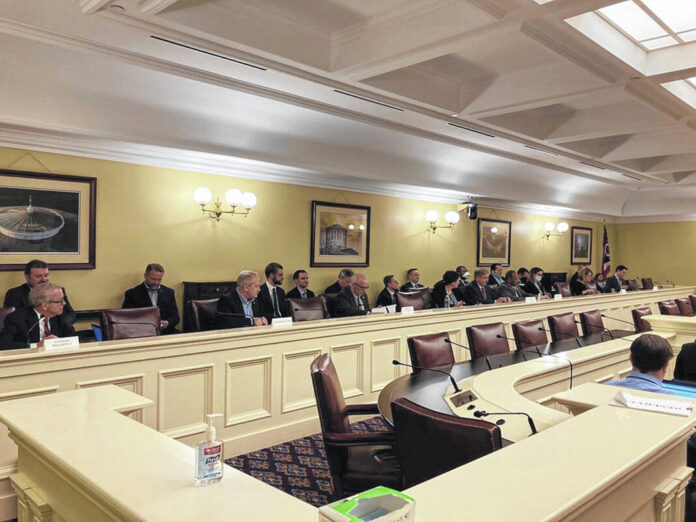
Members of the Ohio Redistricting Commission during a March 19, 2022 meeting. The members, seated in front row from left to right, are: Gov. Mike DeWine, Auditor Keith Faber, Senate President Matt Huffman, House Speaker Bob Cupp, Sen. Vernon Sykes, House Minority Leader Allison Russo and Secretary of State Frank LaRose.
COLUMBUS, Ohio — Ohio Republicans have ignored an Ohio Supreme Court order to approve a new state legislative district map, with a court-ordered Friday morning deadline passing without any official action from the GOP-controlled redistricting commission.
The move makes clear that with a federal court ruling securing their preferred maps for this year’s elections, Republicans plan to ignore the state judiciary’s attempts to enforce the language of redistricting reforms — while waiting for a more favorable Supreme Court makeup following the November election.
The inaction also shows the limits of judicial power to enforce political rules when politicians choose to ignore it. The court hypothetically could try to enforce its orders through a contempt-of-court finding, but repeatedly has declined to do so.
Voters in 2015 overwhelmingly approved the state redistricting process as a change to the state constitution, in an attempt to fix partisan gerrymandering.
Last week, in a ruling rejecting Republicans’ latest submitted legislative map, the Ohio Supreme Court ordered the Republican-controlled Ohio Redistricting Commission to approve a new set of maps before 9 a.m. Friday. The map the court rejected is the same one it rejected in March — and the same one a federal court last month ordered the state to use for this year’s legislative elections, anyway. Any new maps likely would be used for the 2024 elections and onward.
The Ohio Supreme Court-ordered deadline passed Friday without the redistricting commission even holding a meeting. Sen. Vernon Sykes, the top Democrat on the redistricting commission, repeatedly asked Republicans to meet, but they refused. Republicans did something similar in May. The Ohio Supreme Court on April 16 gave them three weeks to approve a new map, but rather than work on something, they waited on what turned out to be a favorable federal court ruling and resubmitted a previously rejected map.
“The Redistricting Commission has violated an order from the Supreme Court of Ohio,” Sykes wrote in a Thursday letter after it became clear the commission wouldn’t meet the deadline. “More alarming is that the Commission continues to violate its constitutional imperative to produce legislative maps for Ohio.”
In a Friday letter to Sykes, Republican state Rep. Jeff LaRe, whom House Speaker Bob Cupp tapped as his replacement to co-lead the redistricting commission, argued the state court has no authority to order the commission to do anything, under the redistricting language in the state constitution.
He also signaled that Republicans plan to draw a map sometime after the November elections, when voters will choose a replacement for Republican Chief Justice Maureen O’Connor, a key swing vote on the court’s rulings rejecting six sets of Republican-drawn maps this year.
LaRe argued in his letter that now that a map has been set for the 2022 elections — thanks to the federal court ruling last month — the redistricting language voters added to the state constitution in 2015 doesn’t give the court authority to order the commission to approve a new map by a specific time.
It also says that approving a new map in the middle of an election for districts under a different set of maps could be confusing to voters. And, he said there are logistical challenges to drawing new districts in the middle of the election cycle, due to constitutional language having to do with assigning state Senate districts based on the most recent election results.
Republicans made similar arguments in a court filing last month, asking the court to wait until after the November elections to issue a ruling on state legislative redistricting. The court declined to wait.
Republican Gov. Mike DeWine, who sits on the redistricting commission, generally agrees with LaRe’s letter, according to Dan Tierney, a spokesman for the governor’s office.
And Sen. Rob McColley, a Republican whom Senate President Matt Huffman tapped as his replacement on the redistricting commission, said he fully agrees with LaRe’s letter.
“Now is not the time to confuse Ohioans any more than they currently are. And since any plan that we adopt will not be effective until an election that is two years away, we should not rush to produce a plan under a highly constrained time frame,” McColley said.
Republicans have a strong political incentive to try to run the clock. O’Connor is leaving office at the end of the year due to judicial age limits. Republican Justice Sharon Kennedy, who repeatedly has voted to uphold the Republican-drawn maps, is running for her seat, as is Democratic Justice Jennifer Brunner, who voted to strike down the Republican-drawn maps.
Two other Republican justices who have voted against the maps, Pat DeWine and Pat Fischer, also are up for re-election against Democratic candidates Marilyn Zayas and Terri Jamison. Republicans expect a favorable political climate this year, and thanks to a new law Republicans approved last year, Supreme Court ballots for this November’s election will show partisan affiliation for Supreme Court candidates for the first time.
In the meantime, there are other ongoing redistricting-related cases before the Ohio Supreme Court.
In a similar, parallel process, the Ohio Supreme Court is considering whether to approve or reject a Republican-drawn congressional map. The map is being used for this year’s elections, but the court could strike it down for 2024 and onward. A ruling is likely sometime this summer. Among the various potential outcomes, the court could order its own map to be drawn, although any finding almost certainly will be appealed to federal court.






